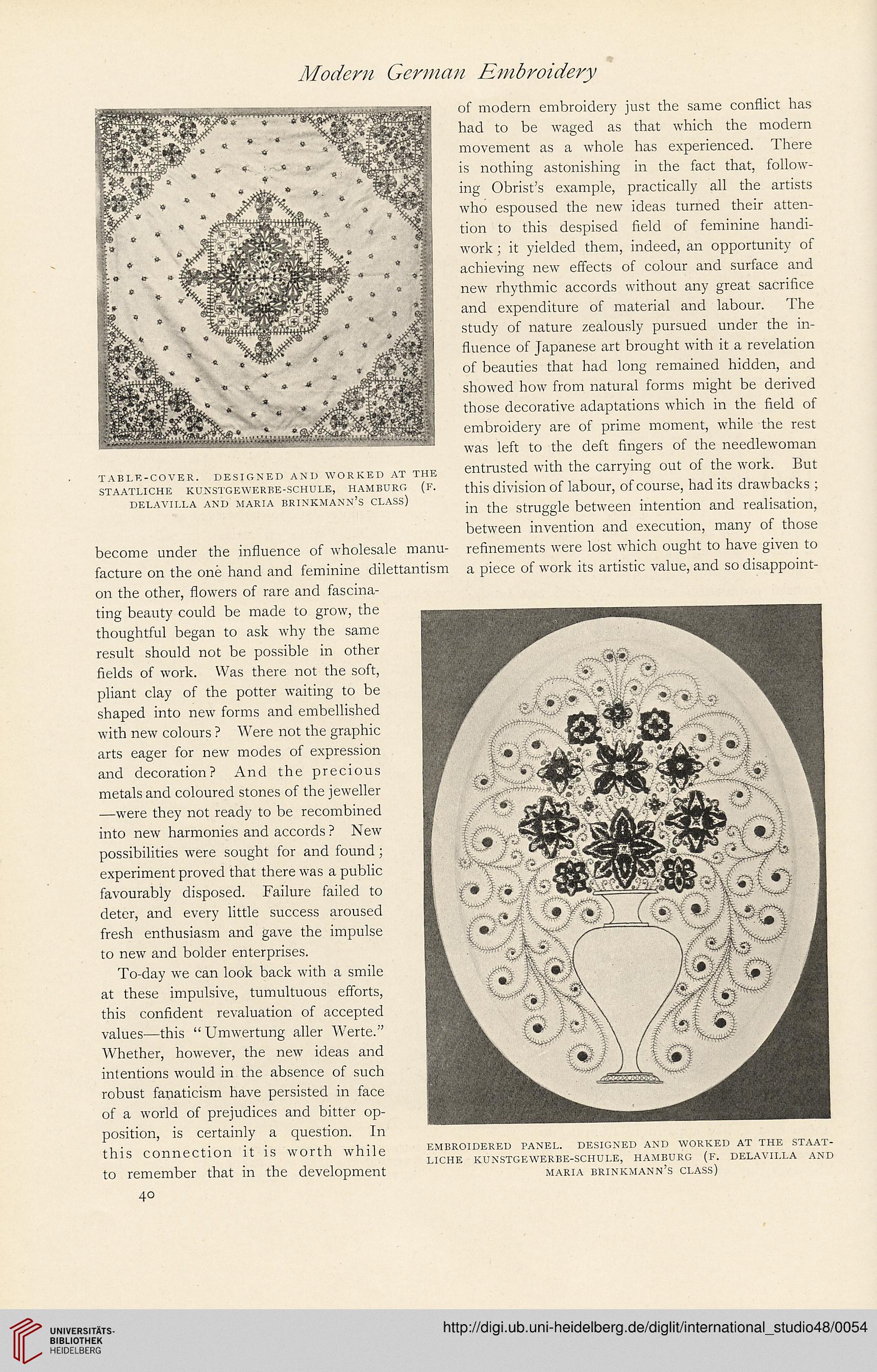Modern German Embroidery
TABLE-COVER. DESIGNED AND WORKED AT THE
STAATLICHE KUNSTGEWERBE-SCHULE, HAMBURG (F.
DELAVII.LA AND MARIA BRINKMANN’S CLASS)
become under the influence of wholesale manu-
facture on the one hand and feminine dilettantism
on the other, flowers of rare and fascina-
of modern embroidery just the same conflict has
had to be waged as that which the modern
movement as a whole has experienced. There
is nothing astonishing in the fact that, follow-
ing Obrist’s example, practically all the artists
who espoused the new ideas turned their atten-
tion to this despised field of feminine handi-
work ; it yielded them, indeed, an opportunity of
achieving new effects of colour and surface and
new rhythmic accords without any great sacrifice
and expenditure of material and labour. The
study of nature zealously pursued under the in-
fluence of Japanese art brought with it a revelation
of beauties that had long remained hidden, and
showed how from natural forms might be derived
those decorative adaptations which in the field of
embroidery are of prime moment, while the rest
was left to the deft fingers of the needlewoman
entrusted with the carrying out of the work. But
this division of labour, of course, had its drawbacks ;
in the struggle between intention and realisation,
between invention and execution, many of those
refinements were lost which ought to have given to
a piece of work its artistic value, and so disappoint-
ting beauty could be made to grow, the
thoughtful began to ask why the same
result should not be possible in other
fields of work. Was there not the soft,
pliant clay of the potter waiting to be
shaped into new forms and embellished
with new colours ? Were not the graphic
arts eager for new modes of expression
and decoration? And the precious
metals and coloured stones of the jeweller
—were they not ready to be recombined
into new harmonies and accords ? New
possibilities were sought for and found;
experiment proved that there was a public
favourably disposed. Failure failed to
deter, and every little success aroused
fresh enthusiasm and gave the impulse
to new and bolder enterprises.
To-day we can look back with a smile
at these impulsive, tumultuous efforts,
this confident revaluation of accepted
values—this “ Umwertung aller Werte.”
Whether, however, the new ideas and
intentions would in the absence of such
robust fanaticism have persisted in face
of a world of prejudices and bitter op-
position, is certainly a question. In
this connection it is worth while
to remember that in the development
EMBROIDERED PANEL. DESIGNED AND WORKED AT THE STAAT-
LICHE KUNSTGEWERBE-SCHULE, HAMBURG (F. DELAVII.LA AND
MARIA BRINKMANN’S CLASS)
40
TABLE-COVER. DESIGNED AND WORKED AT THE
STAATLICHE KUNSTGEWERBE-SCHULE, HAMBURG (F.
DELAVII.LA AND MARIA BRINKMANN’S CLASS)
become under the influence of wholesale manu-
facture on the one hand and feminine dilettantism
on the other, flowers of rare and fascina-
of modern embroidery just the same conflict has
had to be waged as that which the modern
movement as a whole has experienced. There
is nothing astonishing in the fact that, follow-
ing Obrist’s example, practically all the artists
who espoused the new ideas turned their atten-
tion to this despised field of feminine handi-
work ; it yielded them, indeed, an opportunity of
achieving new effects of colour and surface and
new rhythmic accords without any great sacrifice
and expenditure of material and labour. The
study of nature zealously pursued under the in-
fluence of Japanese art brought with it a revelation
of beauties that had long remained hidden, and
showed how from natural forms might be derived
those decorative adaptations which in the field of
embroidery are of prime moment, while the rest
was left to the deft fingers of the needlewoman
entrusted with the carrying out of the work. But
this division of labour, of course, had its drawbacks ;
in the struggle between intention and realisation,
between invention and execution, many of those
refinements were lost which ought to have given to
a piece of work its artistic value, and so disappoint-
ting beauty could be made to grow, the
thoughtful began to ask why the same
result should not be possible in other
fields of work. Was there not the soft,
pliant clay of the potter waiting to be
shaped into new forms and embellished
with new colours ? Were not the graphic
arts eager for new modes of expression
and decoration? And the precious
metals and coloured stones of the jeweller
—were they not ready to be recombined
into new harmonies and accords ? New
possibilities were sought for and found;
experiment proved that there was a public
favourably disposed. Failure failed to
deter, and every little success aroused
fresh enthusiasm and gave the impulse
to new and bolder enterprises.
To-day we can look back with a smile
at these impulsive, tumultuous efforts,
this confident revaluation of accepted
values—this “ Umwertung aller Werte.”
Whether, however, the new ideas and
intentions would in the absence of such
robust fanaticism have persisted in face
of a world of prejudices and bitter op-
position, is certainly a question. In
this connection it is worth while
to remember that in the development
EMBROIDERED PANEL. DESIGNED AND WORKED AT THE STAAT-
LICHE KUNSTGEWERBE-SCHULE, HAMBURG (F. DELAVII.LA AND
MARIA BRINKMANN’S CLASS)
40




